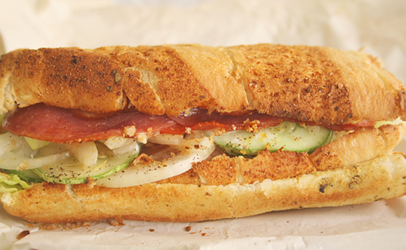 adlines last week when the fast food chain announced it was going to stop using a chemical in its bread that is also used to make yoga mats and shoe rubber.
adlines last week when the fast food chain announced it was going to stop using a chemical in its bread that is also used to make yoga mats and shoe rubber.On Monday, U.S. Sen. Charles Schumer (D-NY) called on the U.S. Food and Drug Administration to ban azodicarbonamide from all foods because it is “suspected to be a carcinogen.”
Azodicarbonamide is a common ingredient used in bread as a dough strengthener and flour-bleaching agent. The chemical is approved and recognized as safe by FDA at a maximum of 45 parts per million, or half an ounce for every 100 pounds of flour.
Subway noted FDA’s designation that the additive is safe and stated that the move is part of an “on-going commitment to provide quality products.”
The announcement came shortly after food blogger Vani Hari launched a petition to have the sandwich chain remove the additive because of its possible health risks.
The company said that the process of eliminating azodicarbonamide from its bread began last year: “We have already developed an improved bread formula, conducted extensive performance and consumer testing on it, and pending final government approvals we should complete the entire conversion process within the coming weeks.”
Despite Subway’s move, the chemical is still used by other fast food chains such as McDonald’s and grocery-store chains, so Schumer has taken the issue a step further. He is now calling on FDA to ban azodicarbonamide from use in food under the federal Food, Drug, and Cosmetic Act’s Delany Clause, which prohibits any amount of food additive or pesticide found to cause cancer from being added to processed food.
“Many countries in the developed world have banned this toxic chemical from food products, and it’s time for the U.S. to follow suit,” Schumer said. “While Subway should be commended for removing it voluntarily, it shouldn’t have even been a choice in the first place. The FDA needs to take another look at this chemical and make sure that the thing that makes our rubber rubbery is not also making our food carcinogenic.”
Lisa Lefferts, senior scientist with the Center for Science in the Public Interest (CSPI), agreed, saying that “there are plenty of breads out there that don’t contain azodicarbonamide and since its use slightly increases exposure to a carcinogen, we really don’t need this.”
A 1999 report on azodicarbonamide published by the United Nations Environment Programme, the International Labour Organisation, and the World Health Organization stated that the chemical can induce asthma in people who work where the chemical is manufactured or used. It may also induce skin sensitization.
Beyond that, the potential health risks are not as well-tested as many would like. “There are no adequate data available relating to carcinogenic, reproductive, or developmental effects; hence, it is not possible to evaluate the risk to human health for these end-points,” stated the 1999 report.
Lefferts said that what we do know is that when bread containing azodicarbonamide is baked, two other suspicious chemicals form.
“One is called semicarbazide and that caused cancers in mice,” she told Food Safety News, but its carcinogenicity in humans is not classifiable, and Lefferts thinks it poses a negligible risk.
“The second breakdown product, however, is urethane, which is a recognized carcinogen,” she said. “The levels that form in bread [containing 45 milligrams per kilogram of azodicarbonamide] do pose a small cancer risk. It’s small but it’s not negligible.”
Lefferts said that she and CSPI would like to see FDA ban azodicarbonamide.
“In lieu of that, they could at least lower the permitted level from 45 milligrams per kilogram because, in their own studies, they found that when it was added, for example, at 20 milligrams per kilogram, the levels of urethane formed were extremely small,” she explained, noting that bakers currently using the chemical are not necessarily using the maximum. “That would be, certainly, a step in the right direction.”
In response to requests for a ban on the additive, an FDA spokesperson said that the agency uses “an extensive, science-based process” for evaluating food additives’ safety and that when they’re used within the approved conditions, there is “a reasonable certainty of no harm.”
“The agency monitors the safety of food additives, including azodicarbonamide, and is prepared to take appropriate action if safety concerns arise,” they said.





